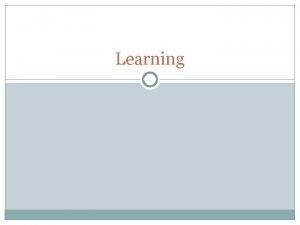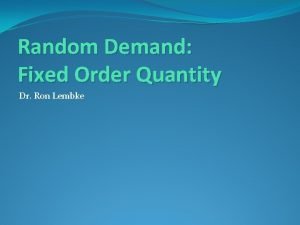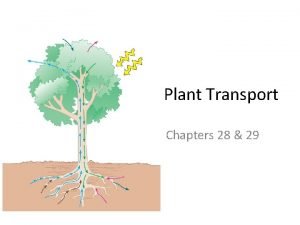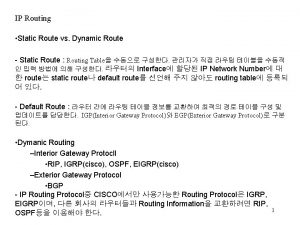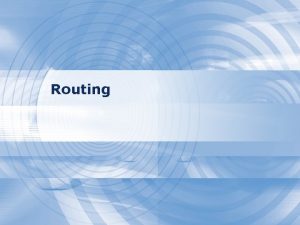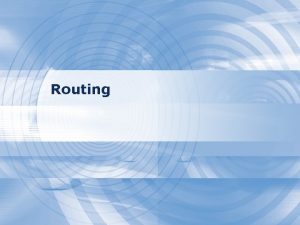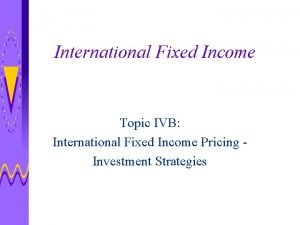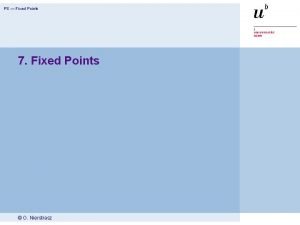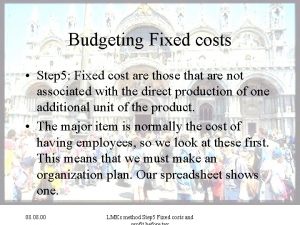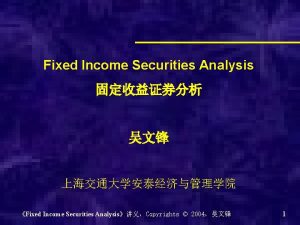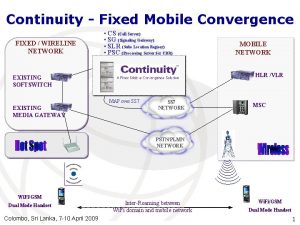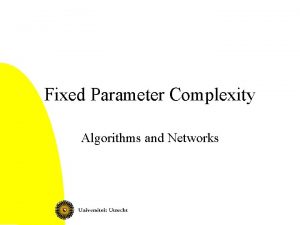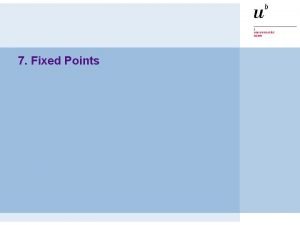Routing Strategies n Fixed Routing A route is












![Comparisons L(n) = min [ L(n), L(x)+w(x, n) ] Lh(x, D) x S … Comparisons L(n) = min [ L(n), L(x)+w(x, n) ] Lh(x, D) x S …](https://slidetodoc.com/presentation_image/4028b44913f2a8b13bcc729466264dcf/image-13.jpg)








- Slides: 21

Routing Strategies n Fixed Routing ¨A route is selected for each source-destination pair of nodes in the network ¨ No difference between routing for datagrams and virtual circuits ¨ Simplicity, but lack of flexibility ¨ Refinement: supply the nodes with an alternate next node for each destination

Routing Strategies (cont) n Flooding ¨A packet is sent by a source node to every one of its neighbors ¨ At each node, an incoming packet is retx on all outgoing link except for the link on which it arrived ¨ Hop count field deals with duplicate copies of a pkt ¨ Properties n All possible routes btw source and destination are tried n At least one copy of the packet to arrive at the destination will have a minimum-hop route n All nodes connected to the source node are visited

Routing Strategies (cont) n Random Routing ¨ Selects only one outgoing path for retx of an incoming packet ¨ Assign a probability to each outgoing link and to select the link based on that probability n Adaptive Routing ¨ Routing decisions that are made change as conditions on the network change n Failure n Congestion

Routing Strategies (cont) n Adaptive Routing ¨ State of the network must be exchanged among the nodes ¨ Routing decision is more complex ¨ Introduces traffic of state information to the network ¨ Reacting too quickly will cause congestionproducing oscillation ¨ If it reacts too slowly, the strategy will be irrelevant

Shortest Path Algorithm n Dijkstra’s Algorithm n Bellman-Ford Algorithm 8 5 3 2 6 2 3 2 1 2 4 6 8 3 3 1 1 7 5 3 1 1 1 4 2 5

• Reduced graph 5 3 2 6 2 1 3 1 2 1 4 1 5

Dijkstra’s Algorithm 2 1 D 2 = 2 4 2 3 D 3 = 5 6 1 4 5 D 4 = 1 1 3 D 3 = 3 D 2 = 2 4 D 4 = 1 D 3 = 4 6 5 D 5 = 2 M = { 1, 4 } M={1} 2 D 2 = 2 3 6 5 D 5 = 2 M = { 1, 2, 4, 5 } D 6 = 4 2 1 D 2 = 2 4 D 4 = 1 3 D 3 = 4 5 D 5 = 2 M = { 1, 2, 4 } 6

Dijkstra’s Algorithm (cont) D Node M 2 3 4 5 6 1 1, 4, 2, 5, 3 1, 4, 2, 5, 3, 6 2 5 1 ¥ 2 2 2 4 4 3 3 3 1 1 1 2 2 2 ¥ ¥ ¥ 4 4 4

Dijkstra’s Algorithm (cont) n w(i, j) = link cost, L(n) = path cost from node s to n n 1. [Initialization] ¨T = {s} ¨ L(n) n = w (s, n) for n ≠ s 2. [Get next node] x Ï T such that L(x) = min L(j) jÏT ¨ Add x to T ¨ Find n 3. [Update Least-Cost Paths] ¨ L(n) ¨ Go = min [ L(n), L(x)+w(x, n) ] for all n Ï T to step 2

Bellman-Ford Algorithm D(2)3 = 4 2 1 3 D(1)2 = 2 4 D(1)3 = 5 2 1 6 3 D(2)2 = 2 5 4 D(1)4 = 1 5 D(2)4 = 1 h=2 D(3)3 = 3 2 1 3 D(3)2 = 2 4 6 5 D(3)4 = 1 h=3 D(3)5 = 2 6 D(3)6 = 4 D(2)5 = 2 D(2)6 = 10

Bellman-Ford Algorithm (cont) D Node h Source = 1 0 1 2 3 4 5 6 ¥ ¥ ¥ 2 5 1 ¥ ¥ 2 2 2 4 3 3 1 1 1 2 2 2 10 4 4

Bellman-Ford Algorithm (cont) n Lh(n) = path cost from s to n w/ no more than h links n 1. [Initialization] n ¨ L 0(n) = ∞, for all n ≠ s ¨ Lh(s) = 0, for all h j s 2. [Update] ¨ For each successive h ≥ 0 ¨ For each n ≠ s, compute ¨ Lh+1(n) link = min [ Lh(j) + w(j, n) ] j <= h links n
![Comparisons Ln min Ln Lxwx n Lhx D x S Comparisons L(n) = min [ L(n), L(x)+w(x, n) ] Lh(x, D) x S …](https://slidetodoc.com/presentation_image/4028b44913f2a8b13bcc729466264dcf/image-13.jpg)
Comparisons L(n) = min [ L(n), L(x)+w(x, n) ] Lh(x, D) x S … D S x …… x Dijkstra’s (Link State) Bellman-Ford (Distance Vector) D

Routing in ARPANET n First generation(RIP), 1969 ¨ Adaptive ¨ Use Routing is adopted Bellman-Ford algorithm ¨ Estimated link delay is simply the queue length for that link ¨ Every 128 ms, each node exchanges its delay vector(routing table) with all its neighbors ¨ Information about a change in network condition would gradually ripple through the network

Routing in ARPANET (cont) ¨ Each node i maintains n di j = current estimate of min delay from i to j n si j = next node in the current min-delay route from i to j ¨ Node k updates its vectors as follows n dk j = Min [ lk i + di j ] iÎA n sk j = i k i j using i that minimizes the expression above where A = set of neighbor nodes for k lk i = current estimate of delay from k to i

Routing in ARPANET (cont) n Major shortcomings of RIP ¨ It did not consider line speed, merely queue length. Higher capacity links were not given the favored status ¨ Queue ¨ The length is an artificial measure of delay algorithm was not very accurate. It responded slowly to congestion and delay increases.

Routing in ARPANET (cont) n Second generation, 1979 ¨ OSPF: Open Shortest Path First protocol ¨ Link-state ¨ The routing protocol delay is measured directly ¨ Every 10 seconds, the node computes the average delay on each outgoing link ¨ Information of changes in delay is sent to all others nodes using flooding ¨ Using Dijkstra’s algorithm

Routing in ARPANET (cont)

Routing in ARPANET (cont) n Third generation, 1987 ¨ Problem n The correlation between the reported values (delay) and those actually experienced after rerouting ¨ Conclusion n Under heavy load, the goal of routing should be to give the average route a good path instead of attempting to give all routes the best path ¨ Solution n Also consider the average utilization of links n Revised cost function: delay-based metric under light loads, capacity-based metric under heavy loads

Calculate Link Costs 1. Measure the avg. delay over the last 10 sec 2. Using the single-server queuing model, the measured delay is transformed into an estimate of link utilization 3. Average the link utilization with the previous estimate of utilization 4. The link cost is set as a function of average utilization

ARPANET Delay Metrics (3 rd) Theoretical queueing delay Delay (hops) 5 4 3 2 1 Metric for satellite link Metric for terrestrial link 0 0. 1 0. 2 0. 3 0. 4 0. 5 0. 6 0. 7 0. 8 0. 9 1. 0 Estimated utilization
 As path override
As path override Route sheet in production planning and control
Route sheet in production planning and control Reservoir routing example
Reservoir routing example Mark tinka
Mark tinka Hydrologic continuity equation
Hydrologic continuity equation Difference between clock routing and power routing
Difference between clock routing and power routing What is fixed routing
What is fixed routing Fixed interval vs fixed ratio
Fixed interval vs fixed ratio Fixed order quantity
Fixed order quantity Example of fixed ratio schedule
Example of fixed ratio schedule Advantages of plds
Advantages of plds Fixed interval vs variable interval
Fixed interval vs variable interval Passive bond portfolio management strategies
Passive bond portfolio management strategies Silk road trade route
Silk road trade route Lahore metro bus route length
Lahore metro bus route length Map of a long walk to water
Map of a long walk to water Silk road indian ocean trans saharan
Silk road indian ocean trans saharan Trans saharan trade route
Trans saharan trade route Route des ecouges
Route des ecouges Route sheet specifies
Route sheet specifies Free route airspace czech republic
Free route airspace czech republic The symplast is the continuum of cytosol connected by
The symplast is the continuum of cytosol connected by







